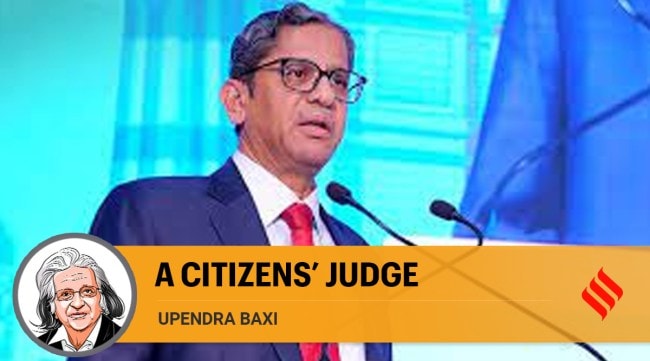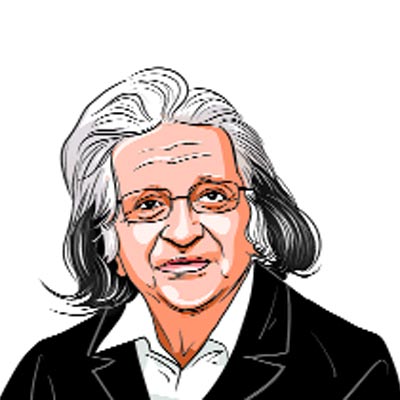Opinion N V Ramana: A citizen’s judge
Upendra Baxi writes: As Chief Justice of India, N V Ramana displayed courage in turbulent times and negotiated a fair balance between judiciary, executive, and Parliament.
 N V Ramana, former Chief Justice of India. (File Photo)
N V Ramana, former Chief Justice of India. (File Photo) Nuthalapati Venkata Ramana, the 48th Chief Justice of India (CJI), had a huge agenda on his plate but an exasperatingly short term of 16 months in office. The 49th Chief Justice of India, Uday Umesh Lalit, who assumed office on August 27, has an even shorter tenure — he retires on November 8, 2022. One wishes for a longer tenure, but two things must be remembered: The overall tenure in the apex court as a Justice is 5.6 years and the average tenure of a CJI is an estimated 1.5 years. On the whole, the record shows that the Supreme Court has served Indian judicial democracy well, although there may frequently be a raging public debate — even discontent — in the Bar as well as media, concerning the judicial contribution towards maintaining constitutional cultures in the corridors of political power.
Justice Ramana’s gentle passion for justice will be long remembered. He wielded great judicial power with grace and humility, tinged with courage and firmness. As CJI, he exercised both organisational adjudicatory leadership (OAL) and hermeneutical (interpretive) judicial leadership (HJL) exceedingly well, with vision and courage.
Three aspects of OAL are worth mentioning here. The first is judicial appointments. In the S A Bobde years, the collegium virtually ceased functioning for reasons not yet fully publicly documented. In CJI Ramana’s short term, not only were 24 vacancies filled up in high courts and more than 100 members appointed to tribunals, but as the Attorney-General K K Venugopal stated, “for the first time, the Supreme Court worked at full strength of 34 judges”. What is more, CJI Ramana merits a place in history for elevating three women judges, of whom one may become CJI by the present order of seniority.
Exceptional also was his emphasis on judicial and law reforms. Speaking at the Statue of Unity in Gujarat, in April, the CJI said that the “concept of alternative dispute resolution (ADR) has the potential to transform the Indian legal landscape by providing a platform for millions of people to settle their grievances,” and asked “courts to take an active effort to make negotiation and mediation mandatory as part of case management”, thus furthering the laudable aims of “Lok Adalats, Gram Nyayalayas, mediation and arbitration centres”. He also emphasised the thorough understanding of new technologies, such as artificial intelligence. He promoted the idea of the Judicial Infrastructure Development Corporation and, in particular, the need for “a planned initiative to upgrade the technical infrastructure of court”.
HJL expanded a great deal with CJI Ramana. Among the most recent examples is the jurisprudentially notable verdict on the Benami Transactions (Prohibition) Amendment Act, 2016. And while it’s true that the Court deals with review petitions within a strictly narrow compass, he not only had the recent PMLA review (on July 27) in the open court but also referred two matters of not providing an Enforcement Case Information Report and reversal of the presumption of innocence to the Bench to be headed by Justice D Y Chandrachud as these “prima facie” require reconsideration. Also touching is the gesture of deference to the two companion justices — Justices Dinesh Maheshwari and C T Ravikumar, who were earlier on the PMLA Bench with Justice A M Khanwilkar — while resisting the review of the entire decision. Equally praiseworthy is the steadfast insistence on the need for a debate to address the issue related to the distribution of freebies by political parties and asking the Centre why “it cannot call for all party meetings to deliberate on the same”. Now, certain issues such as the scope of judicial intervention with respect to the reliefs sought, and “whether the appointment of the expert commission would serve any purpose that required extensive hearing before passing any orders” have been referred to a three-judge Bench.
A Bench comprising CJI Ramana, and Justices Surya Kant and Hima Kohli, marked a judicial advance in opening the sealed Pegasus reports of the technical committee, as well as that of Justice Raveendran and informing the nation that the technical committee examined 29 phones, out of which five had some malware, but “it could not be said to be Pegasus”. CJI Ramana took stern notice that the government had “not cooperated with the committee”. The CJI also added that Justice Raveendran has recommended changes in the existing surveillance law and further that “privacy protections must be enhanced along with the cyber security of the nation”. However, neither that report nor the redacted report of the technical committee was uploaded to the court’s website.
It would be well to remember what this writer wrote in these pages (‘The Court’s voice’, IE, December 17, 2018): “The Court has the constitutional power coupled with a duty to interpret and affirm the fundamental rights and provide constitutional remedies, which is itself a fundamental right under Article 32.” If these “are to be castigated as ‘unlimited powers’, one should always recall that they are constitutional, not celestial, or cosmic powers, and certainly, there are no constitutional “Kamadhenu” powers. The exercise of judicial power is subject to internal dissent and public debate, but neither should be exercised in questioning the constitutional architecture as a whole.” I think that the outgoing CJI has performed this duty well. Justice Ramana was truly a “citizens’ judge” who maintained the “balance even in turbulent times” (as Kapil Sibal said), and was rightly extolled (by Dushyant Dave) for maintaining a “spine” in negotiating the fair “balance” between the judiciary, executive, and Parliament.
The writer is professor of law emeritus, University of Warwick, and former vice-chancellor of Universities of South Gujarat and Delhi





